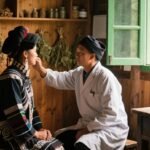Xiangfaluoajiangmian (Irregular Menstruation)
[Overview]
In Miao medicine, irregular menstruation is referred to as Xiangfaluoajiangmian or Liuxiang’ahe. Xiangfaluoajiangmian refers to irregular menstruation in women, characterized by early or delayed periods and unpredictable cycles, corresponding to irregular menstruation in Traditional Chinese Medicine (TCM).
In TCM, irregular menstruation is a general term for diseases caused by dysfunctions in liver and kidney or disharmony of the Chong and Ren channels, resulting in early or delayed menstruation by 1–2 weeks. It is also known as “irregular menstruation cycle,” “period disorder,” or “menstrual confusion.”
In Western medicine, conditions such as uterine fibroids, endometrial polyps, endometriosis, and ovulatory dysfunctional uterine bleeding may present with irregular menstruation and can be treated with reference to this disease.
[Huhoujipeng·Miao Disease Syndrome]
Xiangfaluoajiangmian is classified as a minor disease, divided into two subtypes: hot menstruation type (irregular menstruation due to heat) and cold menstruation type (irregular menstruation due to cold).
[Aijiangduo·Etiology]
This condition has a complex etiology, often due to disharmony of Chong and Ren channels and Qi-blood imbalance, or poor personal hygiene.

[Gengduomeng·Pathogenesis]
In the hot menstruation type, irregular menstruation is mainly caused by excessive liver fire, which disrupts Qi and blood. Since the liver stores blood and governs menstruation, excessive fire causes premature bleeding. In the cold menstruation type, irregularity is primarily due to kidney deficiency, leading to delayed menstruation. The deficiency of Qi and water exacerbates the irregular timing of menstruation.
[Key Diagnostic Points]
Diagnostic Criteria
(1) The main diagnostic feature is early or delayed menstruation with unpredictable cycles. The hot type may present with distending pain in the flanks and dark red menstrual blood with clots; the cold type often involves light-colored, scanty menstrual flow.
(2) It is crucial to rule out systemic or gynecological causes of abnormal bleeding such as hematologic disorders, hepatic or renal failure, thyroid dysfunction, pregnancy-related conditions, trauma, infections, or tumors.
Relevant Examinations
Ultrasound, cytology tests, vaginal smears, cervical mucus crystallization tests, basal body temperature, endometrial biopsy, X-rays, hysteroscopy or laparoscopy, ovarian and pituitary function tests, and when necessary, liver and kidney function tests, hematologic studies, and tissue biopsies.
[Differential Diagnosis]
Xiangfashaji (Beng Lou Syndrome)
In Miao medicine, Xiangfaluoajiangmian is characterized by irregular menstruation, with early or delayed periods. In contrast, Xiangfashaji refers to sudden excessive vaginal bleeding outside of menstruation or persistent spotting, indicating severe menstrual cycle, duration, and volume disturbances.
[Syndrome Differentiation and Treatment]
Hot-type Irregular Menstruation
Mengliduo (Symptoms):
Menstruation occurs early or late, often with difficult flow, variable volume, dark purple blood with clots, distension of the breasts, lower abdomen, or flanks, chest oppression, frequent sighing, poor appetite.
Xingleng (Channel Association):
Belongs to hot menstruation and heat syndromes.
Jiahemeng (Treatment Principle):
Bubenyi Xiang (Tonify Qi and nourish blood), Weishanghangning (Soothe liver and relieve stagnation).
Ouduoxijia, Gang’ou (Prescription and Explanation):
Yimucao (Leonurus japonicus, jia laogei que) 20g
Kudongzi (Melia toosendan, dou jiang e) 18g
Qiancao (Rubia cordifolia, wo yang xi) 15g
Yuejihua (Rosa chinensis, bang bu yang) 15g
Wuyao (Lindera aggregata, wo shan luo) 12g – decocted in water.
Explanation:
Leonurus japonicus (jia laogei que), cold in nature, bitter taste, a cold herb used for hot menstruation to invigorate blood and remove stasis.
Melia toosendan (dou jiang e), cold, bitter, astringent, slightly toxic, regulates Qi and soothes the liver.
Rubia cordifolia (wo yang xi), warm, sour and astringent, used in cold conditions, cools and activates blood.
Rosa chinensis (bang bu yang), warm and sweet, promotes blood circulation and regulates menstruation.
Lindera aggregata (wo shan luo), warm, slightly pungent, warms channels, dispels cold, regulates Qi and relieves pain.
The combination tonifies Qi and blood, regulates menstruation.

Cold-type Irregular Menstruation
Mengliduo (Symptoms):
Irregular periods with scanty, pale, thin blood, dizziness, tinnitus, sore lower back and knees, a sensation of emptiness in the lower abdomen, frequent urination at night.
Xingleng (Channel Association):
Irregular, scanty, pale menstruation belongs to cold menstruation and cold syndromes.
Jiahemeng (Treatment Principle):
Buxue Tiaojing (Tonify blood and regulate menstruation).
Ouduoxijia, Wang’ou (Prescription and Explanation):
Xuduan (Dipsacus asper, wo qiang niu) 20g
Shanyao (Dioscorea opposita, na li) 20g
Turen shen (Talinum paniculatum, wo a ben) 15g
Tusizi (Cuscuta chinensis, ba jie jiang) 15g
Yuejihua (Rosa chinensis, bang bu yang) 12g – decocted in water.
Explanation:
Dipsacus asper (wo qiang niu), warm and sweet, warms and tonifies liver and kidney, regulates menstruation.
Dioscorea opposita (na li), warm and sweet, replenishes Qi and detoxifies.
Talinum paniculatum (wo a ben), warm and sweet, tonifies deficiency and strengthens the spleen.
Cuscuta chinensis (ba jie jiang), warm and sweet, tonifies kidney and consolidates essence.
Rosa chinensis (bang bu yang), warm and sweet, promotes blood circulation and detoxifies.
[Preventive Care]
Treat the root causes.
Keep warm during menstruation; avoid cold stimulation.
Ensure adequate rest, avoid fatigue, improve nutrition and immunity.
Avoid emotional stress; maintain a calm and pleasant mood.
[Commentary]
In Miao medicine, Xiangfaluoajiangmian (Irregular Menstruation) is categorized into hot and cold types. Internal causes include disharmony of Chong and Ren channels and Qi-blood imbalance; external causes include poor hygiene. The hot type is caused by liver fire disturbing blood circulation, while the cold type is due to kidney Qi deficiency. The liver governs dispersing and blood storage; when liver fire is excessive, it disrupts these functions, causing menstrual irregularities. Kidney Qi deficiency leads to insufficient blood production, resulting in irregular periods. Treatment aims to soothe the liver and nourish blood in hot types, and tonify kidney Qi in cold types.
Differential Diagnosis
Xiangfa Luosuo (Early Menstruation), Xiangfa Luonuo (Menorrhagia), and Xiangfa Luodanggang (Prolonged Menstruation)
Early menstruation refers to shortened menstrual cycles. Menorrhagia refers to an excessive volume of menstrual flow. Prolonged menstruation refers to an extended duration of menstrual bleeding. These conditions must be differentiated from Xiangfa Shaji (metrorrhagia and metrostaxis), as the latter involves irregular vaginal bleeding outside of the menstrual period or continuous spotting after menstruation.
Functional uterine bleeding
This condition should be differentiated from Xiangfa Luoajiangmian (irregular menstruation). Functional uterine bleeding often manifests with irregular menstrual cycles but with clearer underlying causes in modern gynecology. Hormonal testing, ovulation tracking, and uterine imaging can aid in differentiating the two.
Treatment by Pattern Differentiation
Hot Syndrome Uterine Bleeding
Symptoms (Mengli Duo): Sudden excessive bleeding during or outside the menstrual period, thick dark-red blood, clots, lower abdominal pain or distension, dizziness, irritability, dry mouth and throat, red complexion.
Syndrome Classification (Xing Leng): Belongs to hot syndrome, excess heat in blood.
Treatment Principle (Jiahe Meng): Clear heat and cool blood (Bu leng lie sang luo xiang).
Prescription (Ouduo Xijia, Formula and Explanation):
Qing dai ye (Indigo naturalis, qing dai) 10g
Ce bai ye (Biota orientalis leaf, ce bai ye) 20g
Xian he cao (Agrimonia pilosa, xian he cao) 15g
Mu dan pi (Paeonia suffruticosa bark, mu dan pi) 15g
Di yu (Sanguisorba officinalis, di yu) 15g
Decoction taken orally.
Explanation:
Qing dai ye is cold in nature, clears heat and cools blood. Ce bai ye is cold, stops bleeding and astringes. Xian he cao is neutral and has hemostatic effects. Mu dan pi and Di yu both clear heat and cool the blood, aiding in halting bleeding and reducing internal fire.
Cold Syndrome Uterine Bleeding
Symptoms (Mengli Duo): Chronic spotting or persistent low-volume bleeding after menstruation, light red blood, dizziness, fatigue, weak limbs, pale complexion, cold limbs, aversion to cold.
Syndrome Classification (Xing Leng): Belongs to cold syndrome, due to qi and blood deficiency.
Treatment Principle (Jiahe Meng): Warm meridians and tonify qi and blood (Bu qi yang xue).
Prescription (Ouduo Xijia, Formula and Explanation):
Dang gui (Angelica sinensis, dang gui) 15g
Chuan xiong (Ligusticum chuanxiong, chuan xiong) 10g
Ren shen (Panax ginseng, ren shen) 10g
Huang qi (Astragalus membranaceus, huang qi) 20g
E jiao (Equus asinus gelatin, e jiao) 10g
Decoction taken orally.
Explanation:
Dang gui and Chuan xiong invigorate blood and regulate menstruation. Ren shen and Huang qi replenish qi. E jiao nourishes blood and stops bleeding. Combined, they warm and nourish the uterus and restore balance.
Prevention and Health Maintenance
Treat the underlying cause actively.
Avoid cold exposure and keep warm, especially during menstruation.
Ensure adequate rest, reduce physical and mental stress, and improve nutritional intake to strengthen the body.
Regulate emotional well-being, avoid excessive emotional stimulation, and maintain a calm and pleasant mood.
Remarks
Miao medicine classifies Xiangfa Luoajiangmian (irregular menstruation) into two minor conditions: “hot menstruation-related irregularity” and “cold menstruation-related irregularity.” The pathogenesis involves both internal and external factors. Internally, it is attributed to imbalance of qi and blood in the Chong and Ren meridians; externally, to poor personal hygiene. The mechanism primarily involves either liver fire causing blood disharmony or kidney deficiency leading to insufficient qi and blood.
Hot-type irregular menstruation stems from hyperactivity of liver fire, disrupting liver’s function of regulating qi and storing blood. When liver fire is excessive, the flow of qi and blood is disordered, resulting in early or irregular menstruation.
Cold-type irregular menstruation arises from kidney deficiency. The kidney is the foundation of innate constitution and the source of transformation for qi and blood. When kidney qi is weak, the transformation and flow of menstrual blood are disrupted, leading to delayed or insufficient menstruation.
Hence, (used in traditional contexts) focuses on regulating liver qi and nourishing kidney qi to restore harmony.


Leave a Reply